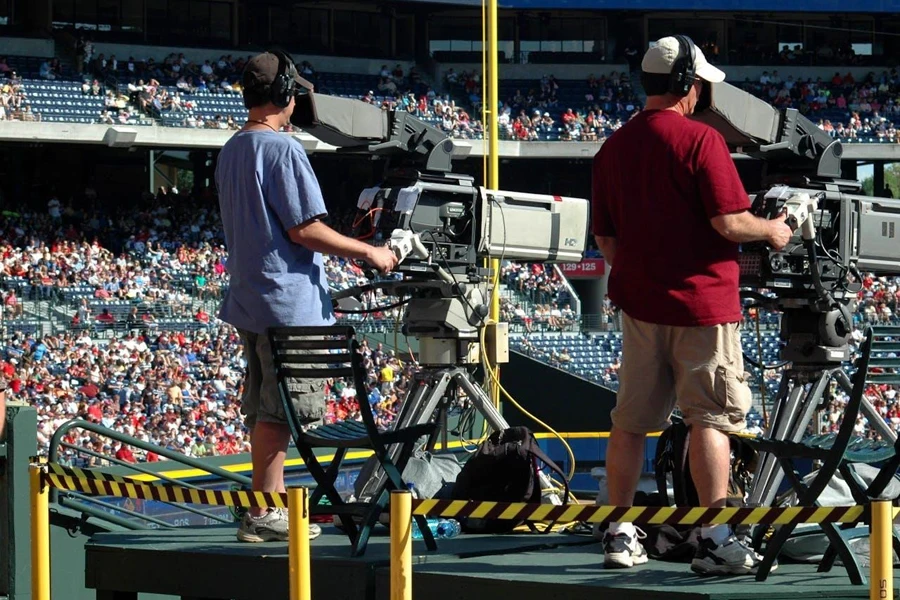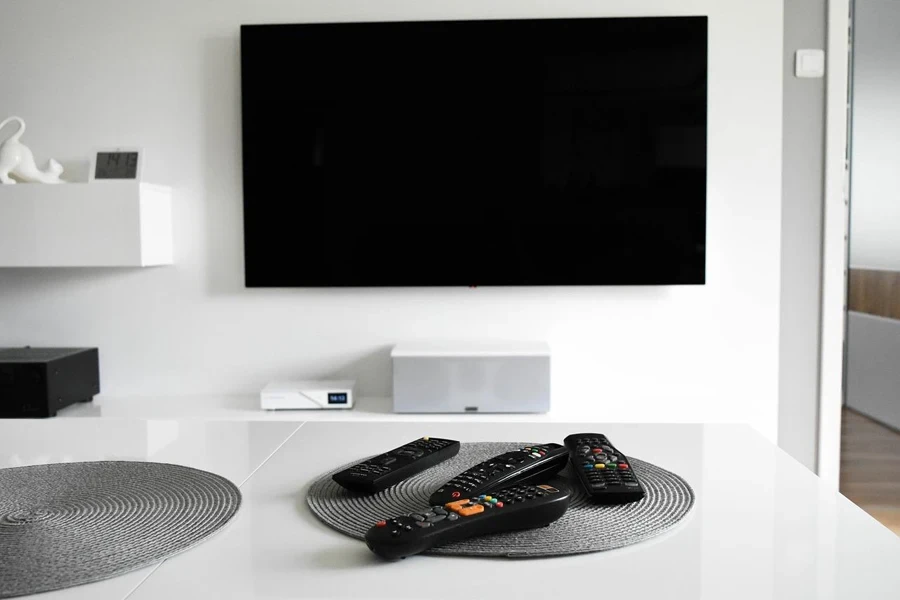Television transmission is crucial in bringing the experience of TV to the public, and this vital innovation is all made possible mainly through the technology of a TV transmitter. Continue reading to explore what a TV transmitter is, its potential in the global market, and how to select transmitters that your buyers will love in 2025.
Table of Contents
TV transmitters and their worldwide market potential
Choosing the right TV transmitter to sell
TV transmitters for different user groups
Low-power TV transmitters
Medium-power TV transmitters
High-power TV transmitters
The bottom line
TV transmitters and their worldwide market potential

The entire TV broadcast process can be lengthy and complex, involving not only extensive technical jargon and devices but also essential knowledge of the overall TV transmission process. For example, TV transmitter systems, outdoor TV antenna, indoor TV antenna, and amplified antenna, or even TV transmitter towers are among the common devices found in broadcast setups. As a seller, let’s focus on the basics and on what a TV transmitter system set can do effectively.
A set of TV transmitter equipment systems serves as the intermediary devices that transmit both audio and video signals from a television broadcasting station to televisions in the home and businesses, assisted by suitable antenna types depending on the coverage required. This includes indoor TV antennas for smaller, enclosed areas and outdoor TV antennas for broader, open coverage.
Like most other broadcasting technologies, TV transmitters initially started as analog devices but have now evolved into primarily digital versions to improve quality and efficiency. Whether it’s a digital or analog TV transmitter, their main roles remain to modulate, amplify, and transmit audio and video signals from a broadcasting station to individual television sets.

Digital TV transmitters, however, incorporate one additional step of digital encoding and compression before the standard modulation process, as video and audio signals must first be converted into digital formats and compressed before they can be efficiently transmitted. It’s worth noting that, however, digital satellite TV transmitters, which primarily use satellite dishes as transmission mediums, are not exactly the same as digital TV transmitters. This is because digital satellite TV transmitters rely on different frequency bands and satellite technology, making them distinct from terrestrial digital TV transmitters.
The end result of adopting digital TV transmitters over analog transmitters is the ability to transmit multiple available channels in high-definition (HD) within the same frequency range, delivering much clearer, digital signals protected from interference to audiences. HD content is made possible through the compression and digital processing in digital transmitters, a capability that analog systems struggle to achieve due to their inherent bandwidth limitations.
In fact, the growing demand for both HD and ultra-high-definition (UHD) content is widely recognized as a critical factor in driving the growth of the global TV transmitter market. Two industry reports concluded that the worldwide TV transmitter market is projected to grow steadily at a compound annual growth rate (CAGR) of 2.3%.
The first report estimated that the market, valued at US$ 627.5 million in 2020, would reach US$ 737.1 million by 2027 over the forecast period from 2020 to 2027. Meanwhile, another report projected growth from US$ 643.1 million in 2023 to US$ 755.5 million by 2030, over the seven-year forecast period. These figures clearly reflect the market’s confidence in the expanding role and relevance of digital TV transmission technology in a rapidly digitizing world.
Choosing the right TV transmitter to sell

Similar to most other broadcasting products, sourcing the right TV transmitter to sell relies heavily on the target segments the sellers aim to reach. For the TV transmitter market, the target customer segments are closely linked to three primary considerations: cost and budget, coverage area, and installation along with long-term maintenance requirements.
In most cases, end users seeking limited coverage solutions only, such as community broadcasts or small-scale local area TV broadcasts, generally have the lowest budgets. Meanwhile, those needing moderate-quality transmission for a specific broadcast region are typically backed by more substantial budgets. Hence, advanced, long-range TV transmitters with higher budget requirements are generally suitable for public broadcasters or premium hospitality sectors aiming to reach a wide and diverse audience.

Furthermore, installation complexity and ongoing maintenance needs, as well as regulatory and licensing requirements, tend to escalate along with the sophistication of the TV transmitters. TV transmitter products with straightforward installation processes, especially plug-and-play designs, are almost always welcomed by smaller scale TV transmitter users, such as education institutions, hotels, and corporate offices. In contrast, high-powered digital TV transmitters and satellite transmitters often require more complex, professional installation and maintenance, therefore more well-suited for large-scale broadcasters.
TV transmitters for different user groups
Low-power TV transmitters

Low-power TV transmitters are specifically designed for Low-Power Television (LPTV) service, which is defined by the Federal Communications Commission (FCC) as “locally oriented television broadcasting.” In other words, these transmitters are well-suited for community broadcasting within small areas, ideal for specific buildings, educational institutions, campuses, hospitals, or residential complexes. Instead of targeting broad public broadcasts, low-power TV transmitters are intended for contained, focused audiences, covering a typical power range of 100W to 600W with a limited broadcast range.
It’s also worthwhile to acknowledge that despite the lower power output of these transmitters, they often still feature advanced technological capabilities, including ATSC 3.0 compatibility and modularity, while supporting most internationally recognized digital standards such as ATSC 3.0, DVB-T/T2, and ISDB-T.
What’s especially notable about this type of device is that rather than having an extensive transmitter setup like those used in full-service broadcast stations or high-power systems (which often require multiple dedicated pieces of equipment, such as separate modulators, amplifiers, and so on), low-power TV transmitter systems may consolidate these functions into just a few or even a single unit. Consequently, these transmitters are specifically aimed at the LPTV market, with streamlined designs that are generally sufficient, efficient, and available at a significantly lower cost.
Medium-power TV transmitters

Medium-power TV transmitters are somewhat less available in the market, especially when compared to low-power and high-power transmitters. The most significant difference is that some manufacturers bypass production of this range altogether, perceiving it as having relatively minor differences from the other two models.
In terms of coverage, medium-power transmitters typically operate within a power range of 1.2kW to 4.5kW, depending on the digital standards in use, such as ATSC, ATSC 3.0, DVB-T, or ISDB-T. This higher power output provides reach over a greater distance than LPTV transmitters, allowing them to serve local stations or community TV stations across several towns or cities. Consequently, these medium-power transmitters are deemed ideal for city-wide or regional broadcasting, offering sufficient power and strong signal strength to cover a moderately sized audience.
Positioned between low-power and high-power options, medium-power TV transmitters often feature a full suite of transmission components, including separate modulators, amplifiers, and encoders. However, they generally offer fewer customization options and less flexibility than high-power systems.
High-power TV transmitters

Since the higher the power of a TV transmitter, the stronger its transmission capability, which in turn also means a much wider coverage area—high-power TV transmitters are naturally designed for larger organizations or applications requiring extensive reach. This is also why high-power and full-service broadcast stations typically require a comprehensive transmitter setup, often including complete sets of transmission equipment, with each component dedicated to ensuring stronger signal quality and penetration for broader reach.
For example, high-power transmitter setups frequently include standalone modulators to convert the baseband signal into the desired frequency for transmission. They also have separate amplifiers to boost broadcast signal strength, along with encoders and exciters to convert audio and video signals into widely used digital formats like MPEG or H.264.
Hence in actual fact, whenever sellers refer to high-power TV transmitters, they are typically talking about a complete set of TV transmission equipment housed within rack-mounted units, resembling various computer “servers” but functioning as an integrated broadcast system. All components are generally sold and packaged together, forming a single transmitter system with multiple specialized parts working in tandem.
In view of their powerful capabilities which typically range from 3kW to 11kW per a single standard 19’’ rack, high-power TV transmitters can cover large areas and hence are suitable for national or regional broadcasts. This extensive coverage is ideal for public broadcasters who need to reach a broad, diverse audience across wide geographic areas, including urban areas, multiple cities, or even across country borders.
The bottom line

TV transmitters are essential in any television broadcast setup. Just as selection of a right TV antenna can have a direct impact on the quality of TV program reception, effective TV broadcasting begins with the selection of the most appropriate TV transmitters. Digital TV transmitters are now the worldwide industry standard, gradually replacing analog transmitters due to their enhanced efficiency and capabilities in supporting multichannel transmission and multiplexing features that allow for reliable HD and UHD content delivery.
Coverage area, budget limitations, installation, and long-term maintenance requirements are the three main factors that sellers should carefully evaluate when selecting TV transmitters to sell. These considerations are closely tied to the varying needs of different customer segments. Low-power, medium-power, and high-power digital TV transmitters are the three primary types that address distinct customer demands and user groups; sellers should choose carefully to meet these specific needs effectively.
Seeking to fuel business growth with deeper insights, more wholesale sourcing ideas, and practical logistics guidance? Visit Chovm.com Reads regularly to discover the strategies needed to drive continuous improvement.





 Afrikaans
Afrikaans አማርኛ
አማርኛ العربية
العربية বাংলা
বাংলা Nederlands
Nederlands English
English Français
Français Deutsch
Deutsch हिन्दी
हिन्दी Bahasa Indonesia
Bahasa Indonesia Italiano
Italiano 日本語
日本語 한국어
한국어 Bahasa Melayu
Bahasa Melayu മലയാളം
മലയാളം پښتو
پښتو فارسی
فارسی Polski
Polski Português
Português Русский
Русский Español
Español Kiswahili
Kiswahili ไทย
ไทย Türkçe
Türkçe اردو
اردو Tiếng Việt
Tiếng Việt isiXhosa
isiXhosa Zulu
Zulu